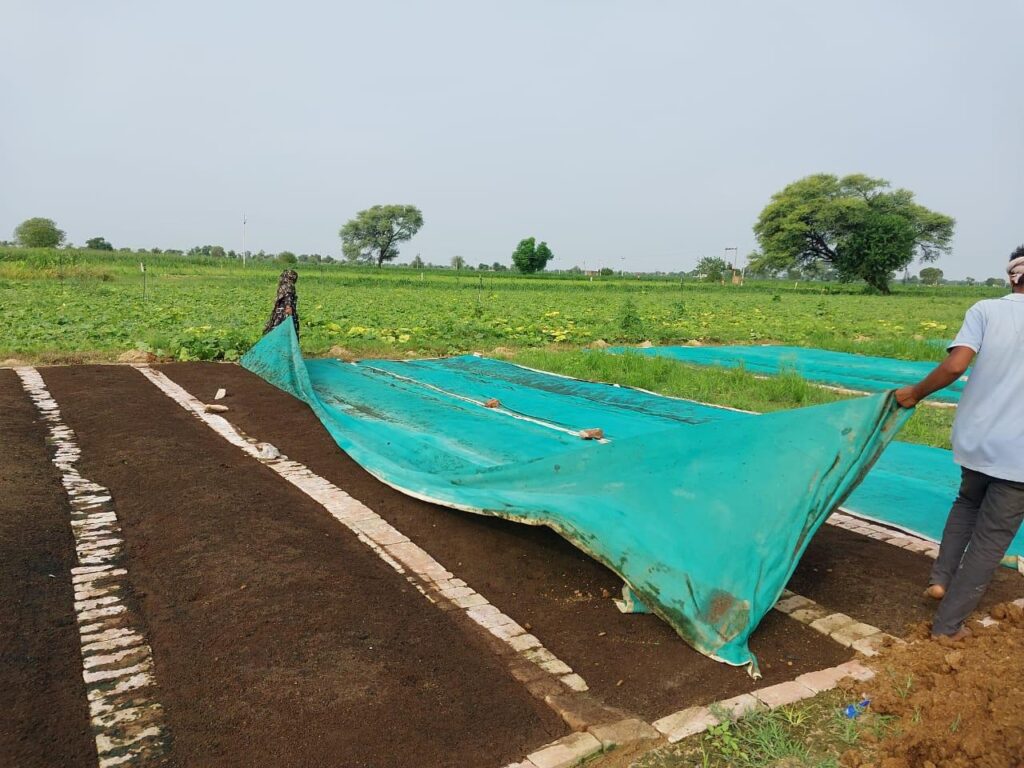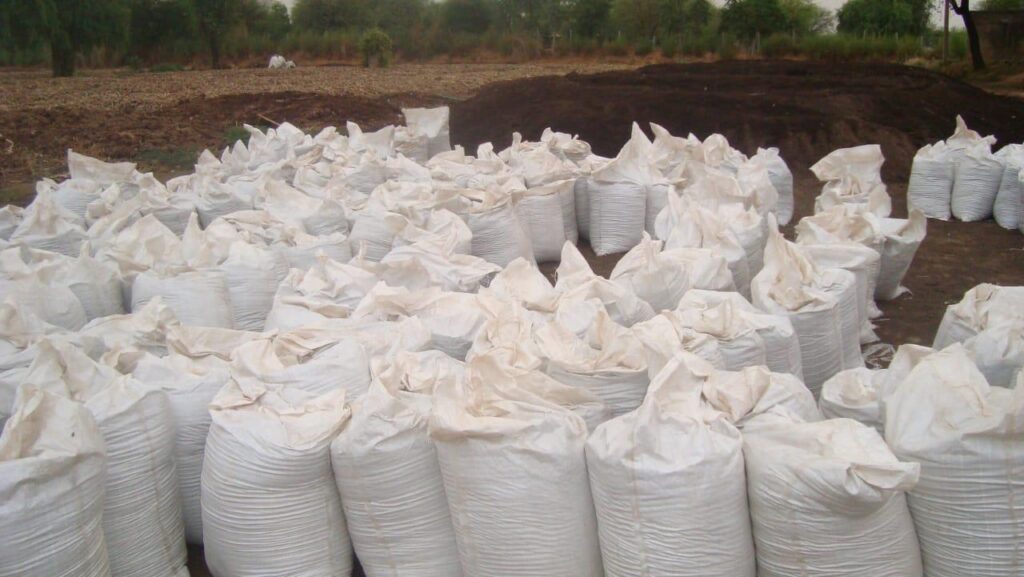🏗️ 1. Site Selection & Vermicompost Unit Setup
Ideal Location:
- Shaded area (natural or artificial shade like thatch, net, or shed)
- Well-drained soil (or concrete base)
- Close to water source and organic waste supply
Unit Types:
- Cemented beds/pits
- Brick-lined structures
- HDPE vermibeds (ready-made)
- Wooden or plastic bins (for small-scale/indoor)
Basic Vermi Bed Size (example):
- 10 ft x 3 ft x 1 ft (L × W × H)
- Raised slightly for drainage and easy management

🌾 2. Raw Materials Required
- Cow dung (preferably aged or partially decomposed)
- Biodegradable organic waste:
- Vegetable peels, fruit waste
- Crop residues, dry leaves, sugarcane trash
- Kitchen waste (no oil, meat, dairy)
- Bedding material:
- Coconut coir, straw, sawdust, shredded cardboard
- Water (non-chlorinated)
🔄 3. Pre-Decomposition of Organic Waste
Why? Fresh waste generates heat and acidity that can harm earthworms.
Process:
- Mix cow dung and organic waste in a 1:1 ratio.
- Pile and leave for 10–15 days for partial decomposition.
- Turn the pile every 3–4 days and keep it moist.
- Optional: Add 1–2% lime to neutralize acidity.
🪵 4. Vermi Bed Preparation (Layering)
- Base Layer (Drainage):
- 2–3 inches of dry leaves, husk, or broken bricks.
- Bedding Layer:
- 4–6 inches of partially decomposed cow dung + plant waste.
- Earthworm Layer:
- Release earthworms on top (1 kg per 100 kg of waste).
- Feeding Layer:
- Lightly cover with another thin layer of waste or cow dung.
Do not bury the worms deep. Let them settle on their own.
🐛 5. Selection & Introduction of Earthworms
Best Species:
- Eisenia fetida (Red Wigglers)
- Eudrilus eugeniae (African Nightcrawler)
- Perionyx excavatus (Indian Blue)
Quantity Required:
- 1 kg of earthworms per 1 cubic meter of bedding (or 100 kg waste)

🌦️ 6. Maintenance During Composting
Moisture:
- Maintain 60–70% moisture.
- Sprinkle water regularly; don’t let it dry.
- Avoid overwatering (can cause anaerobic conditions).
Temperature:
- Ideal: 20–30°C
- Avoid extreme heat or cold.
- Use shade nets, thatch, or shelter.
Aeration:
- Turn the top layer lightly once a week.
- Ensure proper airflow and avoid foul smells.
Protection:
- Keep away from ants, rodents, and birds.
- Use mesh covers or natural barriers.
⏳ 7. Composting Duration
- Time required: 30–45 days
- Depends on:
- Temperature
- Moisture
- Type of feedstock
- Worm species
Signs of Completion:
- Dark brown/black, granular compost
- Earthy smell (no foul odor)
- No visible raw waste
- Worms may move to bottom or disappear from surface
🥚 8. Earthworm Reproduction Process (During Composting)
How Earthworms Multiply:
- Earthworms are hermaphrodites: have both male & female organs.
- Two worms mate and produce cocoons from the clitellum.
- Each cocoon hatches in 2–4 weeks, producing 1–3 baby worms.
- Worms mature in 40–60 days, and begin reproducing again.
Under good conditions, the population doubles every 30–45 days.
🧹 9. Harvesting Vermicompost
Separation of Worms:
- Stop watering 3 days before harvest.
- Pile compost into mounds under light—worms move to bottom.
- Remove top layers manually.
- Alternatively, use sieves or mesh to separate worms.
Sieving & Cleaning:
- Use a mesh to remove clumps and foreign material.
- Recycle unprocessed material back into the next batch.
🌞 10. Drying & Storage
- Dry compost in shade (not direct sun) to preserve microbes.
- Reduce moisture to around 20% for storage.
- Store in breathable bags (HDPE, gunny sacks) in a cool, dry area.
📦 11. Packaging
- Pack in 1 kg, 5 kg, 25 kg, or 50 kg bags based on market demand.
- Label with:
- Brand name
- Date of manufacture
- Nutrient content (optional)
- Usage instructions

🧪 12. Nutrient Content of Vermicompost (Approximate)
| Parameter | Value |
|---|---|
| Organic Carbon | 9.5 – 17.98% |
| Nitrogen (N) | 0.5 – 1.5% |
| Phosphorus (P) | 0.1 – 0.3% |
| Potassium (K) | 0.15 – 0.56% |
| pH | 6.5 – 7.5 |
| Moisture | 20 – 25% (final) |
| C:N Ratio | 15:1 – 20:1 |
| Beneficial Microbes | High (enzymes, bacteria) |
🌿 13. Uses of Vermicompost
- Home/kitchen gardens
- Organic farming
- Potted plants & nurseries
- Lawns & landscaping
- Seedlings & nursery beds
⚠️ Common Mistakes to Avoid
- Using fresh, undecomposed waste
- Letting beds dry out
- Overfeeding or piling too much waste
- Direct exposure to sun or rain
- Adding oily, spicy, or chemical waste
🪱 Vermicompost – Product Information
🌿 Product Name:Vermicompost
Agroquality Vermicompost
📦 Product Description:
Agroquality Vermicompost is a 100% organic, natural fertilizer made from decomposed cow dung and farm waste using composting earthworms (Eisenia fetida). Rich in essential nutrients and beneficial microbes, this compost enhances soil fertility, promotes healthy root growth, and improves crop yield—all without the use of chemicals.
🧪 Nutrient Composition (Approximate):
| Parameter | Value |
|---|---|
| Organic Carbon | 9.5 – 18% |
| Nitrogen (N) | 0.5 – 1.5% |
| Phosphorus (P₂O₅) | 0.1 – 0.3% |
| Potassium (K₂O) | 0.15 – 0.6% |
| pH | 6.5 – 7.5 (Neutral) |
| Moisture | <25% |
| C:N Ratio | 15:1 – 20:1 |
| Microbial Count | Very High (Active) |
✅ Features & Benefits:
- 🌱 Enhances soil structure and aeration
- 🐛 Increases microbial activity in soil
- 💧 Improves water retention capacity
- 🌾 Promotes healthy root development
- 🔄 Reduces need for chemical fertilizers
- 🍃 100% organic & safe for all plants
- ♻️ Environmentally friendly & sustainable
🌾 Suitable For:
- Vegetable and fruit crops
- Flowers and ornamental plants
- Terrace & kitchen gardens
- Nursery and pot plants
- Organic farming
📦 Packaging Available:
- 25 kg, and 50 kg bags
(Custom packaging available for bulk buyers)
🛠 Usage Instructions:
- Soil Mixing: Mix 1 part vermicompost with 3 parts soil.
- Top Dressing: Apply 200–500g around the base of the plant every 15–20 days.
- For Pots: Use 100–200g per pot monthly.
🛑 Storage Instructions:
- Store in a cool, dry place away from direct sunlight and water.
- Keep the bag tightly closed after use.
